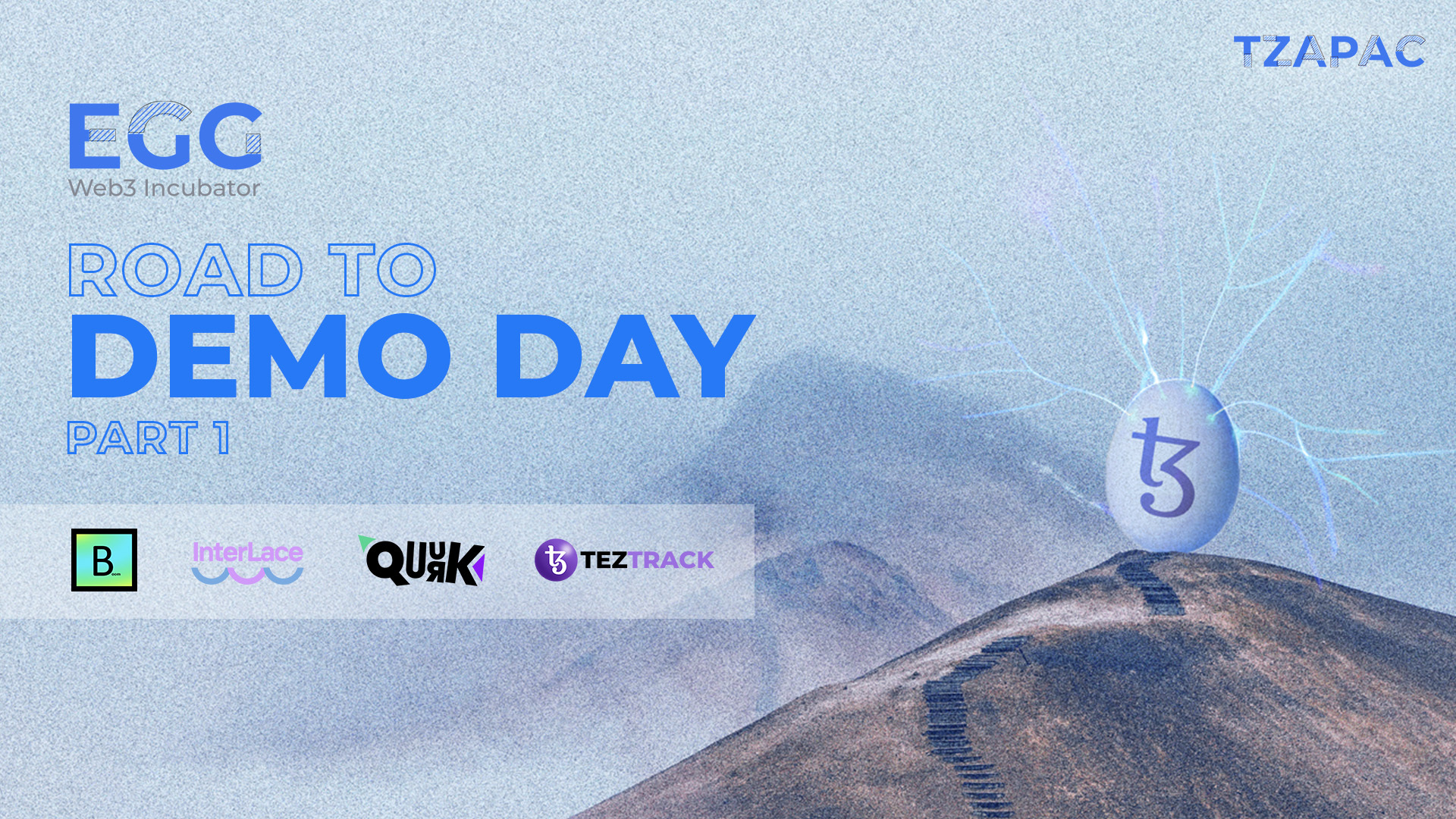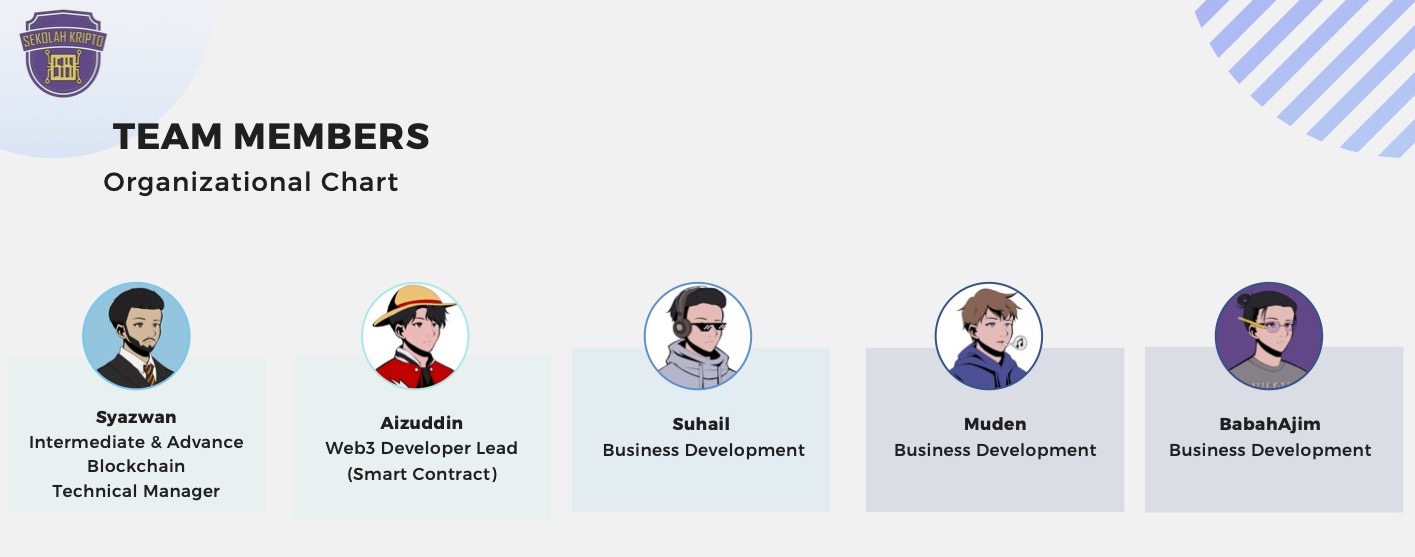IN
IN
JPN
EN
Join Our Communities

The countdown has started - three weeks left to Demo Day (7 December 2022)!
On 15 September, TZ APAC kicked off the EW3I where 23 teams from 8 countries were chosen for their incredible potential to create real-world Web3 solutions.
Get an overview of these 23 projects here: The 23 Projects on Tezos Changing the Game: Inside Cohort 1 of the TZ APAC EGG Web3 Incubator
The EGG Web3 Incubator provides these budding projects with high levels of support, including:
Demo Day will see the project founders participate, where they will be given 3 minutes to present their pitch to some of industry’s top mentors and investors participating.
These investors will then make their assessment - of the project’s quality and potential, business strategy, and even the founders themselves. Investors will include high-profile figures from esteemed organizations like Newman Capital, Draper Startup House, Amber Group, Samadhi Ventures.
The mentors in attendance include Vikram Bharati (Draper Startup House), Laurent Dedenis (Chainstack), Cici Lu (Vennlink), Bobby Ong (CoinGecko), Mona Zoet (RegPac Revolution), TZ APAC’s own Julian Low, and many more.
4 of the projects looking forward to making a flying impression of themselves during Demo Day include Boom, Interlace, Quurk, and Teztrack. Here’s a deeper look into their vision and journeys
Projects Covered:

Boom is the world’s first Web3 Social-Fi marketplace that combines consumer retail storefronts and products, cryptocurrency, and NFTs.
Today, many brands rely heavily on social platforms and influencer marketing, blurring the lines between brands/sellers and content creators. Imagine a platform where creators and sellers can be one and the same - taking branding, social marketing, and e-commerce to the next level.
Uniquely, on it screenshots or saving images are impossible on Boom - which brings back true digital scarcity, and highlights the value proposition of NFTs. Its native features include Boom Bazaar (where brands can reward and connect with their community using NFTs), and Boom Social (token-gated private chat groups and communities).
With over 1,100 signups (as of 27 October 2022) for Boom’s pre-access, it is clear that crypto-natives immediately see the value of Boom, and its potential to change the e-commerce game.
Boom explains that with traditional Web2 social and e-commerce platforms, the main issues that creators and sellers face are the lack of monetization and the risk of data privacy.
Boom exists to solve the severe deficiencies of traditional e-commerce and social platforms, by offering a trading ecosystem where everyone can be a creator of tradable, utility-packed, social NFTs, which may grant access to virtual social clubs, podcast events and much more within the platform itself.
Retailers are empowered to set-up customizable storefronts (which accept payment in cryptocurrency). They may also launch NFTs, which unlock custom experiences on Boom Social, the social half of the Boom ecosystem. Through this, retailers can enhance their branding and community.
Users are made a core part of the brand experience, through interacting with the ecosystem, while generating revenue by trading their Social NFTs within the Boom Ecosystem.
All parties enjoy full control over their content and generated revenue, and can deploy funds freely and quickly - regardless of transaction size, and with extremely low transaction costs.
Boom envisions that in 6-8 years, it will be a critical disruptor of consumer and social markets, as the leading blockchain Social Commerce Ecosystem globally.
Ani and Felix are seasoned blockchain natives, and have over 12 years of combined experience in the space under their belt, across various roles in leadership, operations, and technical domains.
“What we love about our team is that we are tenacious, persistent, bold and pragmatic in driving our vision forward. Hard-and-smart working individuals, Ani & Felix are the right one-two-punch combination who are technically knowledgeable, savvy, and aware of the growing landscape of Web3!” - Ani Srinivas

Ani Srinivas, CEO & CTO of Boom, is a Program Manager for an automotive group in Toronto, with a Bachelor’s in Mechanical Engineering and a Double Master’s in Industrial Engineering and Project Management.
Since 2016, Ani has worked on several tokenomic architectures, composed technical whitepapers, as well as provided strategic operations advisory for a myriad of blockchain project ecosystems. He has also been involved in the development of several Web-3 protocols, particularly in the domain of Social NFTs, where he scaled a product from 1,000 active users to 100,000 active users in a span of 7 months.
Additionally, Ani’s consulting has allowed him to draft technical whitepapers, design tokenomic architectures, as well as create unique utilities for NFTs.
Placing emphasis on both technical expertise and the emotional intelligence required to facilitate and steer ships to fruition, Ani’s leadership will take Boom to the leading spot it deserves.

Felix Sim, Co-Founder & COO of Boom, has been active in the blockchain space since 2018, with experiences across different areas within blockchain. He has consulted and guided various crypto projects on strategy and operations.
Felix has accumulated extensive experience in finance and accounts during his time as an external auditor. With his entrepreneurial mindset, it isn’t surprising that he has already started his own business in the education industry.
It was in 2018 that Ani met Felix in a Discord channel. Holding similar philosophies about blockchain, they quickly became good friends. During this time, Felix was rapidly gaining expertise in driving operations and strategic efforts for various protocols, particularly in community-driven projects, signaling to Ani that he was the right fit for Boom.
Ani says: “We witnessed several intelligently driven NFT/Social NFT projects, which failed due to a severe lack of utility. The primary “utility” the founders found in these projects was only based on the hype of purchasing NFTs and getting more users to the platforms. No focus was given on how to sustain the ecosystem after the users were on-boarded.
For instance, when thousands of users were on-boarded to a social NFT platform that we consulted for, there was no incentive for users to continue using that system - because there was nothing that could be done with the purchased NFTs.
So, over a period of time, the interest in the platform dropped along with hype and momentum. That NFT platform, like many others, lost the trading volume fees that they were so critically dependent on. It’s clear that for users to have long-term appetite for social & non-social NFT platforms, providing utility is crucial.
It was during these dark times that the concept of Boom was born. It is the first product that simultaneously gives true underlying value to NFTs, while addressing the critical problems of current Web2 ‘Dump Commerce’ platforms. Since Boom’s inception, we have received tremendous positive momentum from varied external inputs, and we are extremely excited to continue on this trajectory!”

Interlace is a platform built to connect decentralized organizations (DAOs) to connect with contributors and freelance workers, providing on-chain reputation management, contributor onboarding, and “Proof of Work” payment transparency.
Let’s start by examining the tailwinds that Interlace is leveraging upon.
Web3 blockchain will completely transform the existing conventional processes of the different sectors. Some experts at Market Research Future predict that in 2023, the Web3 sector will be worth over 6 trillion dollars. Web3 will continue to grow at a CAGR of 44.6% from 2023 to 2030, making it one of the fastest growing sectors for the next decade.

Meet Danielle Spence, the founder of Interlace. With over 7 years of product design experience and specialization in designing consumer-facing products, Dani’s skill sets are much needed in the world of Web3. In fact, she also co-founded the NFT collective korii, which helps inform interested artists how to start an NFT collection.
But as we know, Web3 isn’t exactly the most beginner-friendly. In fact, it takes quite a great deal of courage and humility to take the first step into a space with complex terms, knowledge requirements and an entirely unique culture
“Two years ago, I found the transition to Web3 very intimidating and questioned the safe path to contribution. Nevertheless, my curiosity of the space outweighed that uncertainty, so I continued my exploration.
I started like how you start with anything new in life, with the guidance and support of someone with experience. That experience came in the form of a community; that community called itself a DAO. After learning more about the Web3 space through this DAO, I was starting to feel more confident in my ability to contribute, so I extended myself to do some design work for the DAO to build my reputation. But things began to get messy when design asks turned into full-on workloads with unrealistic timelines and compensation.
I realized that not only was my contribution pathway hazy with no direction leading to my pursuits and goals, but many people needed clarification on what it takes to be a DAO contributor and how they can be one. That’s when I created InterLace, a platform to streamline the process and help people transition into the world of DAO contribution. InterLace is doing that by setting clear expectations and strategies to contribute to Web3.”
Dani shares more about her mission and challenges:
“My mission is to create a safe space for decentralized organizations and contributors to connect, contribute, and build. With a short runway trying to push things forward with our Mission & Vision can sometimes feel a bit difficult. But what keeps us going is the value and impact the InterLace Marketplace will have on people.
We’re so grateful for the support and resources provided in this program and what we have learned so far. Things are looking up!”
Dani also feels blessed to have her team standing behind her:
“The awesome thing about my team is that they’re not afraid to get their hands dirty, and love identifying and solving any problems that arise.
We’re the right team to solve this problem because we’re composed of people that understand the frustrations and pain points people face transitioning from Web2 to Web3. We’re here to help break the ice by connecting a wide range of people and skill sets to DAOs and Web3 projects.”
Dani’s challenges are far from unique - the reality is that every day on the ground, Web3 natives seeking work are stumped by how to proceed, and DAOs looking for human capital face novel challenges.
To go deeper, the issues that these stakeholders face are:
For DAOs and protocols - Web3 communities that work towards building out their mark in Web3, and occasionally need to look outside their core team to accomplish a task so that they can focus on core activities, we have a marketplace of qualified contributors. DAOs and protocols usually turn to Telegram, Discord, or Twitter to find Web3 talent. However, there is little to no verification process of contributor’s qualifications.
For Contributors/Freelancers - crypto-natives or people new to Web3 that want to build Web3 portfolios and on chain contributions. The main frustrations are lack of project and payment transparency when working with a DAO.
Let’s take a deeper look at some of the challenges that Web3 freelancers face.
Connection: There’s no easy way to put yourself out there as a contributor to find DAOs. Additionally, DAOs can find talent through job boards, but benefit greatly if they are able to get the contributors already existing in their community.
Onboarding: The main communication channel for DAOs, Discord, lacks a process for members to gain context and information. It is difficult to onboard contributors and get them up to speed, giving them the right information and resources at the right time.
Contributing: DAOs struggle to scope out work for contributors creating a lack of transparency for both contributors and DAOs.
So what does Interlace do to improve the lives of freelancers and DAOs?
Interlace is already working on partnerships, aiming to integrate platforms such as Achievement, Attendance, and Participation Protocols, Educational/Learn-to-Earn Platforms, Identity Systems, Proof-Of-Personhood Protocols, and Marketing (Quest-to-Earn) platforms.
https://www.interlace.community
https://twitter.com/Interlacehq

Quurk is driving a new advent of learner-oriented Regenerative Finance (ReFi) game economies in Web3, by building games that educate and reward learning outcomes whilst creating social impact with youths-at-risk. Built on the fundamentals of ReFi capital by a team with years of experience in serious games, the Quurk ReFi ecosystem advocates a sustainable economic model that goes beyond just rewards.
Being in an industry projected to be worth USD$32.7 billion by 2030, Quurk has a team that has won multiple awards (including Most Downloaded Content in the US App Store in the Education category).
Quurk aims to be recognised as the innovation leader in developing game-based learning products that provide equitable access to education for all, generate positive social impact, and upskill and uplift human capital.
The Problem
Currently, an overwhelming number of youth are ill-equipped with the relevant skills needed to fulfill the demand of the workforce, as we move forward toward a 4th industrial revolution. The current education system is not enough - alongside additional factors like limited access to information and infrastructure for nurturing the next generation in developing countries.
While education has always been a driving force for the underprivileged to escape the grips of poverty; it has now become a significant debt burden for many families around the world. The education system has consistently become more expensive, more stringent, and less engaging - creating an ever-growing disparity. The advent of Web3 presents a clear pathway and opportunity to achieving a free and equitable education for all.
The Solution
Enter ‘serious games’ - an industry projected to be worth $32.7b by 2030. It harnesses the entertainment and engagement factor of video games, combined with learning strategies, knowledge and structures to help learners gain better understanding of topics and gain complex competencies.
However, while game-based learning is rising to the fore as an effective and progressive tool for learning, its business model is still very much traditional - from the typical subscription-based to licensing-based models. These traditional models put undue risk to a game launching in the space, requiring considerable traction for a game to break even, notwithstanding the need to measure its social impact on its users.
So how does Quurk leverage decentralized technology to de-risk a game’s entry into the market? By adopting a free-to-play model backed by a Regenerative Finance (ReFi) token ecosystem, Quurk will drive velocity and liquidity in the ecosystem. Additionally, their ReFi model will upskill and uplift human capital, creating new job opportunities by providing economic incentives aligned with education to allow users to apply and monetise their knowledge gained.
This also encourages a community-centric approach that facilitates great P2P exchange, achieving community goals, and generates profits that can be channeled to initiatives for social impact by helping to educate youths in at-risk communities.
Further, data driven analytics provide a comprehensive blueprint for Quurk to identify successful learners, improvise pedagogical design and gameplay.
Quurk’s initial product is the world’s first Web3 powered gamified learning environment, Pastopia - a sandbox environment to fund, create, and sustain their vision of equitable access to education.

In Pastopia, users can:
Access Quurkverse, a marketplace that will allow players to freely interact and transact their items, as well as issue bounties to incentivise players to build for them.
Learn and Earn - Players not only earn token rewards, but also accreditation that will have real world value. Income is reinvested into at-risk youths.
Participate in Game-Based Learning - Utilizing Gagne’s Conditional Learning Theory to create open world games centered on fundamentals of Computational Thinking for STEM.
Use Soulbound Tokens (SBTs) that not only record a player’s progress but are nested to allow an arbitrary system of tradable traits.
The core of their gameplay is founded on the principles of computational thinking that’s imbued into their STEM curricular design and coding, creating a game-based approach to help educate users as they quest to make gains in the vast gameverse, developing the long term development of a student.
In summary, this is what Quurk offers:
An entertaining yet content-rich learning game that makes learning fun
Equitable access to coding curriculums from world renowned organizations in the form of open-world gameplay for youths
A channel for players to earn accreditation through gameplay stored in their soul-bound token
Community-centric P2P model that allows for a more invested community and a more rewarding experience
Accreditations on the blockchain and token rewards
Quurk’s team consists of members that have been in the Web3 space since 2015, with experiences spanning successful ICO launches, NFT projects, developing core token economics, and technology architecture. The team’s co-founder and lead developer have significant experience in the education space, with the latter still working as a lecturer at a local university.
The co-founding team commands decades-long expertise in both game-based learning and blockchain, launching multiple projects in crypto whilst winning several accolades for game-based learning along the way.
The game development team has more than a decade’s experience in developing successful award-winning game products as well as NFT projects in the space.
The blockchain team consists of individuals that are highly experienced in designing token economy and blockchain architecture. They have launched multiple projects in the space of GameFi, DeFi and Layer 1 technologies.
The team has also forged valuable connections in the space. On top of being a part of TZ APAC’s EGG Web3 Incubator, they have also established a partnership with 42, a world renowned coding academy to integrate their curriculum into Quurk’s gameplay.
“Our team members share a common passion and have an extensive knowledge in education, game-based learning and blockchain technology. Our founding team understands the importance of giving back to education as beneficiaries ourselves and how education has played an intrinsic role in uplifting the living standards of mankind.
Our shared passion and combined knowledge and experience has banded us together to start a project that can bring about a profound change to how education functions in a world dominated by technology and knowledge. We will harness the power of gaming and blockchain to bring about a radical transformation that will result in education being more equitable for everyone.” - Marvin Das, Co-Founder (Quurk)

There’s no shortage of things to do in the vibrant Tezos ecosystem, home to over 2 million active artists, NFT collectors/traders, gamers, blockchain enthusiasts, and DeFi hunters. However, there currently isn’t a way to track your total balance of coins/tokens and NFTs across all wallets, nor discover new projects, which is absolutely crucial for power users.
Teztrack offers a current solution to a current problem. Teztrack is designed to provide users with an all-in-one portfolio tracker, social network, and home base in the Tezos ecosystem. Their Social-Fi integrated platform is a beautiful synthesis of convenience and community, where users can explore the latest in the Tezos ecosystem across NFT, DeFi, and gaming. With easy access to data and insights, users can look forward to smarter spending decisions, tighter communities, and a smooth experience in the Tezos ecosystem.

The team and company behind Teztrack is MySekolahKripto - one of the Tezos ecosystem’s strongest supporters on the ground, doing good work to empower people with the knowledge and skills needed to navigate the tricky world of Web3. They educate local communities through both online channels and physical classes, utilizing a not-for-profit business model where sales & grants received are used to provide free courses for the Malaysian community.
With a mission to expand beyond Malaysia and penetrate global markets as a Web3 community hub and more, MySekolahKripto is a young, hungry, and crypto-passionate team.
“We want to do more to enhance Web3 adoption in Malaysia, increase exposure, and cash inflow of Tezos tokens and coins, adoption of wallets like Kukai and Temple, and especially support all Malaysian projects within the Tezos ecosystem! Through Teztrack, we will also provide people with hands-on knowledge on how to use and operate the Tezos chain and bakers (validators), developer tools, digital identity, and DeFi. We hope to instill the true spirit of decentralization in our users.”
